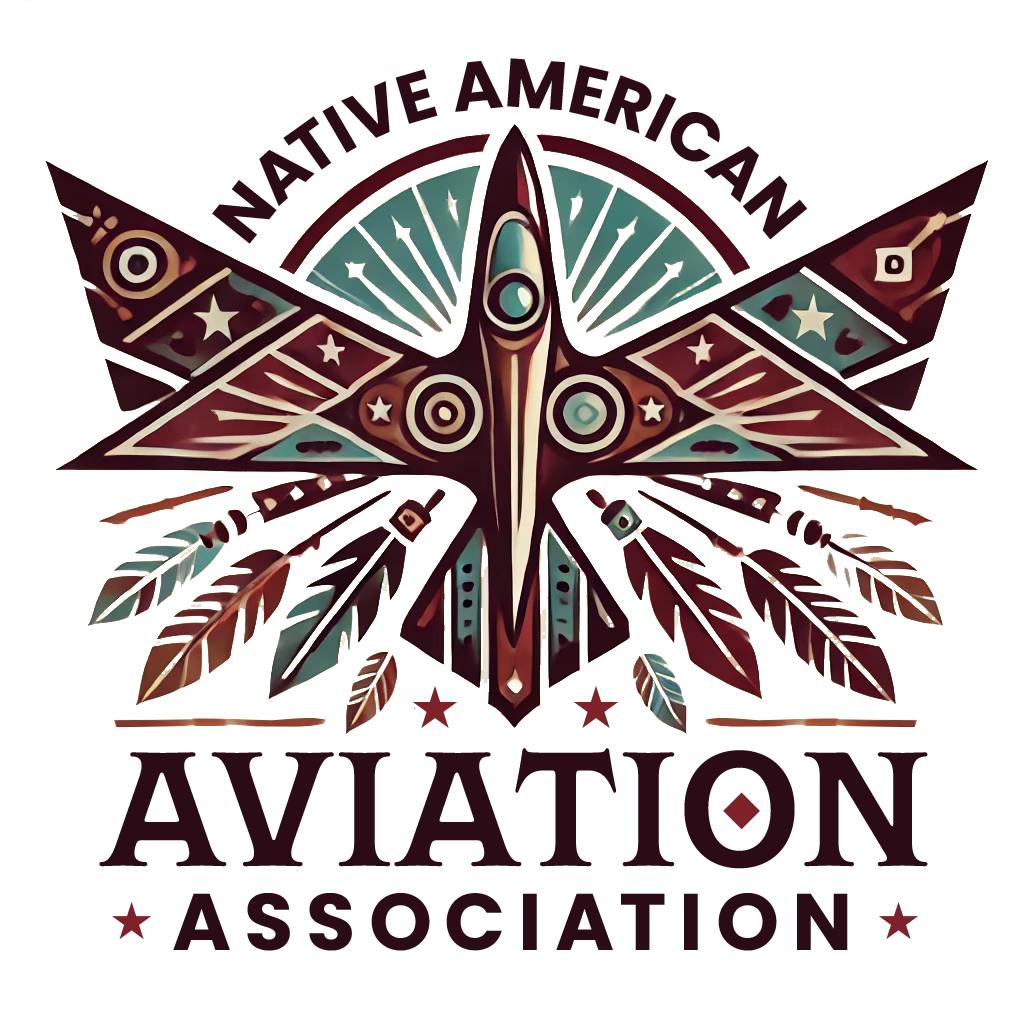
- Details
- By Levi Rickert
The Native American Aviation Association (NAAA) is lifting Indian Country to new heights, ensuring that Native youth and professionals are not just part of the aviation industry but are leading it. Like eagles soaring above sacred lands, NAAA is creating pathways for Native talent to harness the vast opportunities in aviation.
Founded by Kevin J. Allis, a member of the Forest County Potawatomi Community, NAAA is bridging Indian Country and aviation through structured education, technical training, and career pathways. Allis, an experienced pilot with over three decades in aviation, believes flight is not just about physics but about freedom, opportunity, and vision. “This dream is about ensuring that Indian Country is no longer just watching from the ground but soaring alongside the rest of the world,” said Allis.
NAAA’s Board of Directors includes distinguished Native professionals and aviation leaders who guide the organization’s mission. Board Chairman Timothy Goulet (Turtle Mountain Chippewa) leads alongside Vice-Chairman Billy Winburn IV, Secretary Lycia Ortega (Quechan), and Treasurer Shawn Pensoneau (Kickapoo). Other board members include Tressa Mattingly (Chickasaw), Arlando Teller (Navajo), Jeremy DeBons (Osage), Maddie DuBray (Rosebud Sioux Descendant), Josh Henderson (Cherokee), and Joe Hiller (Oglala Sioux). Goulet emphasizes that NAAA is about more than aviation—it's about creating new opportunities for Native youth and professionals.
NAAA’s structured programs guide students from aviation exposure to rigorous training and sustainable careers. The Foundations in Aviation Program introduces Native high school and college students to aviation through career exploration, hands-on STEM learning, flight simulations, and exposure to airline and airport operations.
To support aspiring professionals, NAAA’s Mentorship and Internship Programs connect students with experienced aviation leaders. Native pilots, air traffic controllers, and aerospace engineers serve as mentors, providing career advice, resume workshops, and hands-on industry exposure. Internships with major airlines, aerospace companies, and aviation maintenance firms help students transition from training to employment.
For those ready for career training, NAAA offers structured Career Pathway Programs. The Aviation Maintenance Technician Certification program, guided by FAA-certified professionals, leads to FAA Airframe and Powerplant (A&P) Certification, opening doors to careers as aircraft mechanics and avionics specialists. Future pilots can enroll in Private Pilot License (PPL) Training to master flight controls, aerodynamics, and aviation safety. Those interested in engineering and aviation technology receive training in aircraft design, aerospace mechanics, and flight systems. NAAA’s long-term goal is to offer aviation training on tribal lands through mobile simulators and industry partnerships, making education accessible and empowering.
As NAAA reaches new heights, it actively builds partnerships with aviation organizations, airlines, educational institutions, and federal agencies. These alliances fuel NAAA’s mission, ensuring Native students have access to knowledge, scholarships, resources, and career opportunities. Strong industry partnerships support program development, mentorship, and internships, enabling Native aviation professionals to thrive. These collaborations strengthen tribal economies, increase workforce representation, and ensure Native professionals play a vital role in aviation’s future.
Beyond education and training, NAAA serves as a central hub for Native aviation interests, providing industry news, funding updates, and policy advocacy. Through its Aviation News and Resource Hub, NAAA keeps Native aviation professionals informed about FAA regulations and aerospace advancements. Workshops, tribal aviation summits, and leadership forums provide the knowledge and support tribal communities need to navigate the evolving aviation landscape.
For Indian Country, the sky is not the limit—it is only the beginning. With every Native student who steps into a cockpit, repairs an aircraft, engineers aviation systems, or directs air traffic, NAAA is proving that tribal communities are rising and thriving. “This is an incredible opportunity to showcase an inspiring, dynamic industry with the next generation of leaders,” said Board member Tressa Mattingly.
Arlando Teller, former Assistant Secretary of Tribal Affairs at the U.S. Department of Transportation, echoes this sentiment: “Through education, mentorship, training, and strategic partnerships, NAAA is ensuring that the future of aviation includes the voices, talent, and leadership of Native people.”
For those who wish to support this vital mission—whether through scholarships, mentorship, industry partnerships, or program sponsorships—the opportunity to uplift Native aviation professionals is here. The wind is at our backs, the runway is clear, and the time to fly is now. To learn more, visit www.nativeaviation.org and join the movement to help Native talent take flight.
The Native American Aviation Association is a 501(c)(3) organization dedicated to delivering industry-leading aviation education and career development skills to American Indians and tribal communities through thoughtfully designed, multi-phase programming.
More Stories Like This
Native News Weekly (August 25, 2024): D.C. BriefsUS Presidents in Their Own Words Concerning American Indians
Indigenous Actor Elaine Miles Reports Detention by Alleged ICE Agents
Happy Thanksgiving from Native News Online
Coming Up on Native Bidaské: Behind the Animation: Joey Clift Talks “Pow” and Native Storytelling
Help us tell the stories that could save Native languages and food traditions
At a critical moment for Indian Country, Native News Online is embarking on our most ambitious reporting project yet: "Cultivating Culture," a three-year investigation into two forces shaping Native community survival—food sovereignty and language revitalization.
The devastating impact of COVID-19 accelerated the loss of Native elders and with them, irreplaceable cultural knowledge. Yet across tribal communities, innovative leaders are fighting back, reclaiming traditional food systems and breathing new life into Native languages. These aren't just cultural preservation efforts—they're powerful pathways to community health, healing, and resilience.
Our dedicated reporting team will spend three years documenting these stories through on-the-ground reporting in 18 tribal communities, producing over 200 in-depth stories, 18 podcast episodes, and multimedia content that amplifies Indigenous voices. We'll show policymakers, funders, and allies how cultural restoration directly impacts physical and mental wellness while celebrating successful models of sovereignty and self-determination.
This isn't corporate media parachuting into Indian Country for a quick story. This is sustained, relationship-based journalism by Native reporters who understand these communities. It's "Warrior Journalism"—fearless reporting that serves the 5.5 million readers who depend on us for news that mainstream media often ignores.
We need your help right now. While we've secured partial funding, we're still $450,000 short of our three-year budget. Our immediate goal is $25,000 this month to keep this critical work moving forward—funding reporter salaries, travel to remote communities, photography, and the deep reporting these stories deserve.
Every dollar directly supports Indigenous journalists telling Indigenous stories. Whether it's $5 or $50, your contribution ensures these vital narratives of resilience, innovation, and hope don't disappear into silence.
 The stakes couldn't be higher. Native languages are being lost at an alarming rate. Food insecurity plagues many tribal communities. But solutions are emerging, and these stories need to be told.
The stakes couldn't be higher. Native languages are being lost at an alarming rate. Food insecurity plagues many tribal communities. But solutions are emerging, and these stories need to be told.
Support independent Native journalism. Fund the stories that matter.
Levi Rickert (Potawatomi), Editor & Publisher

